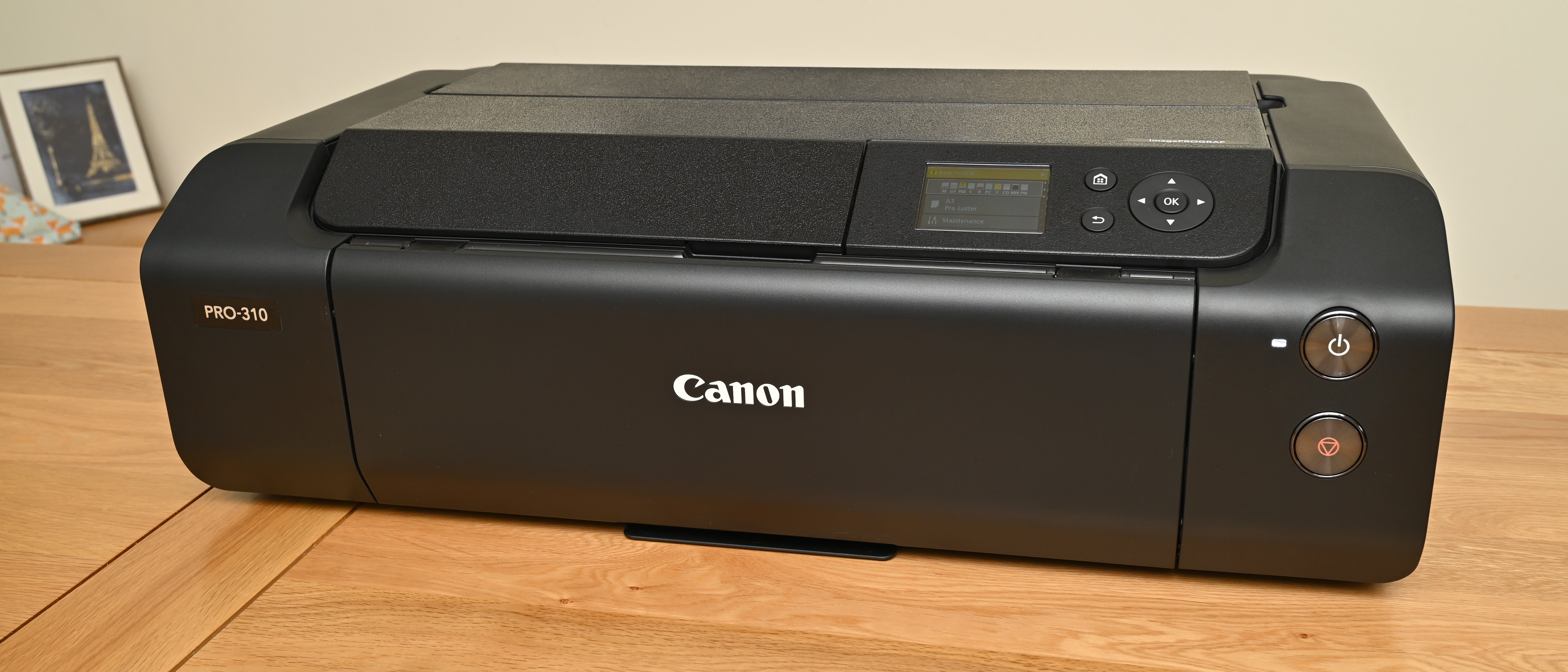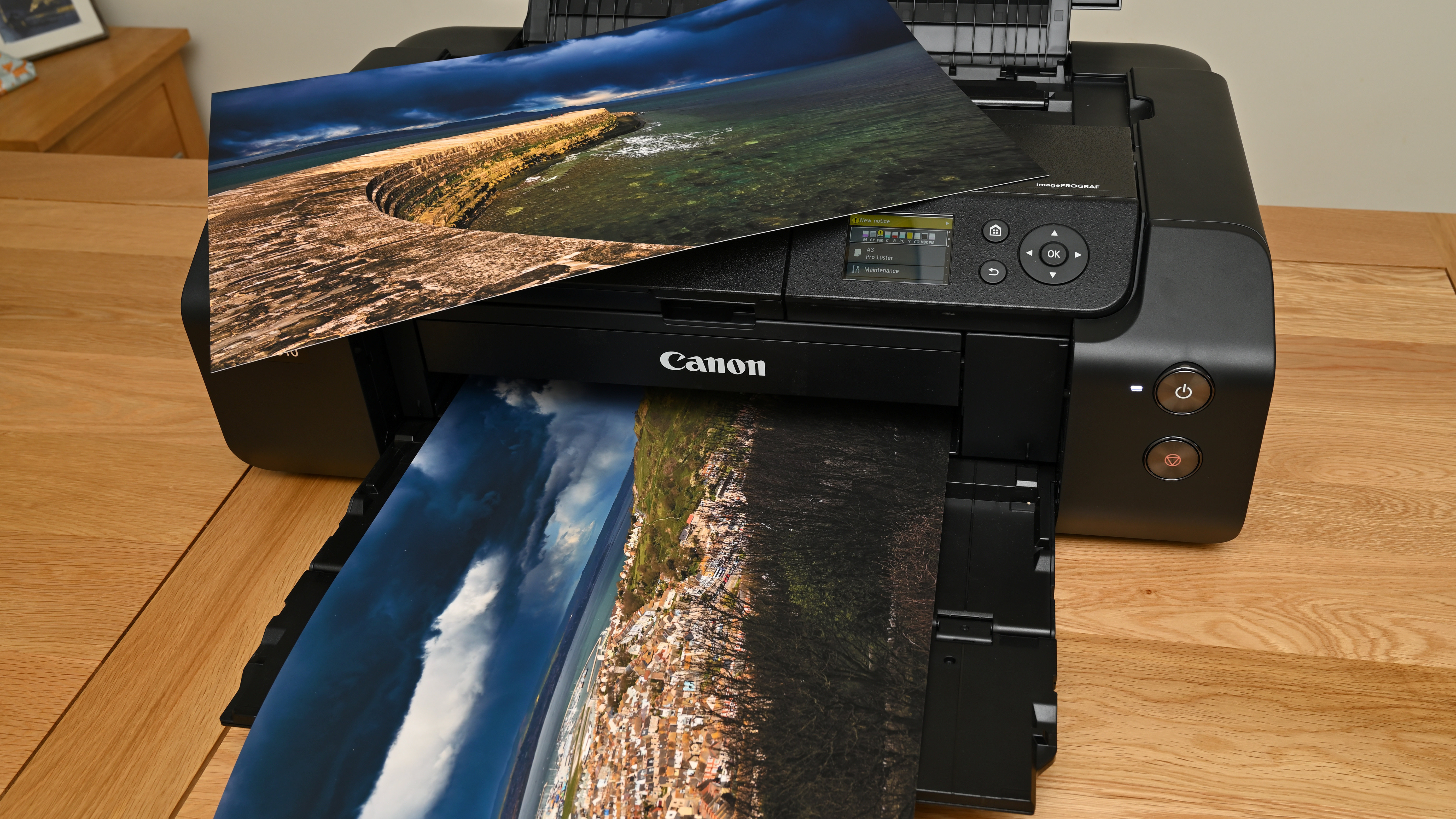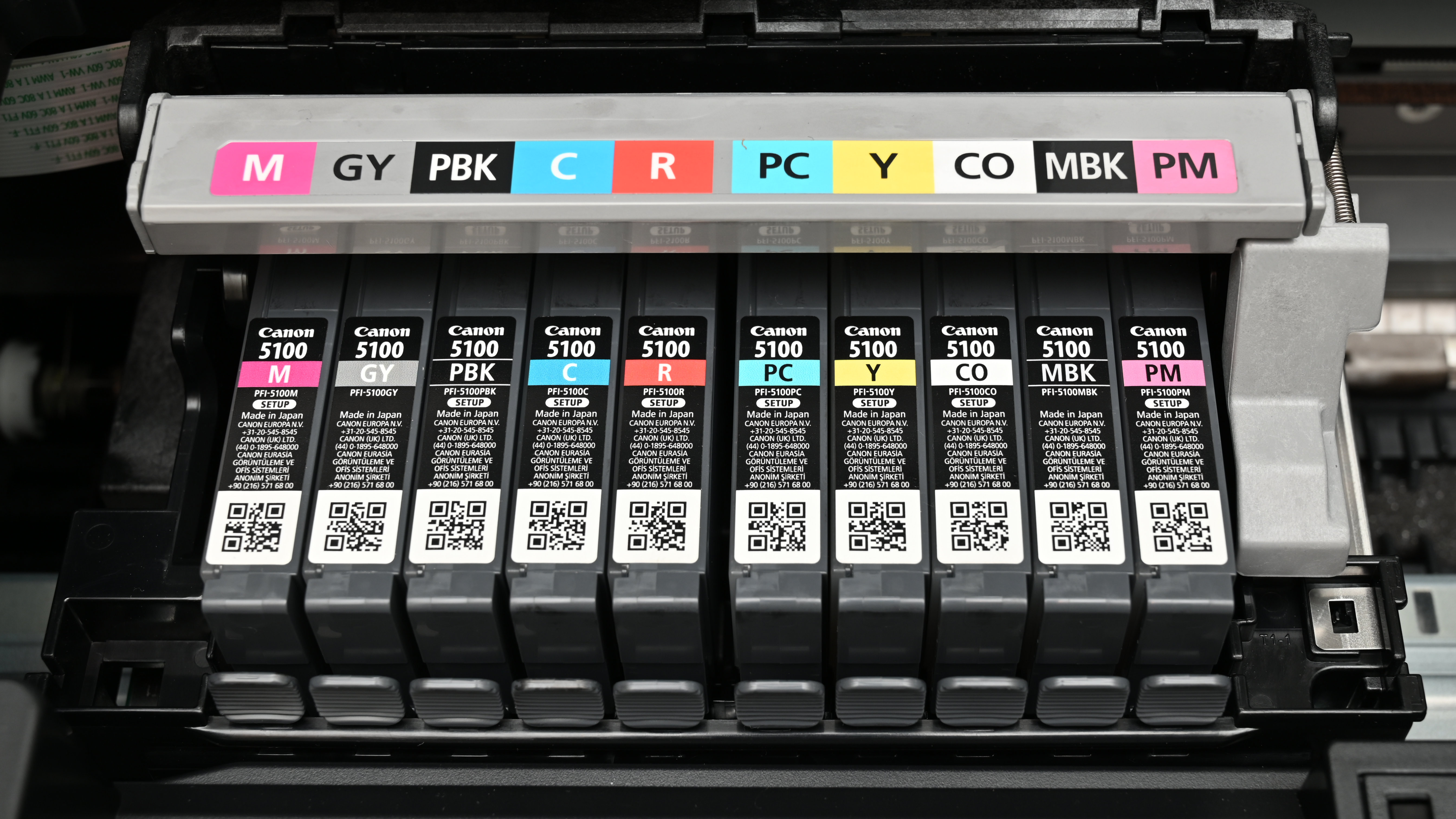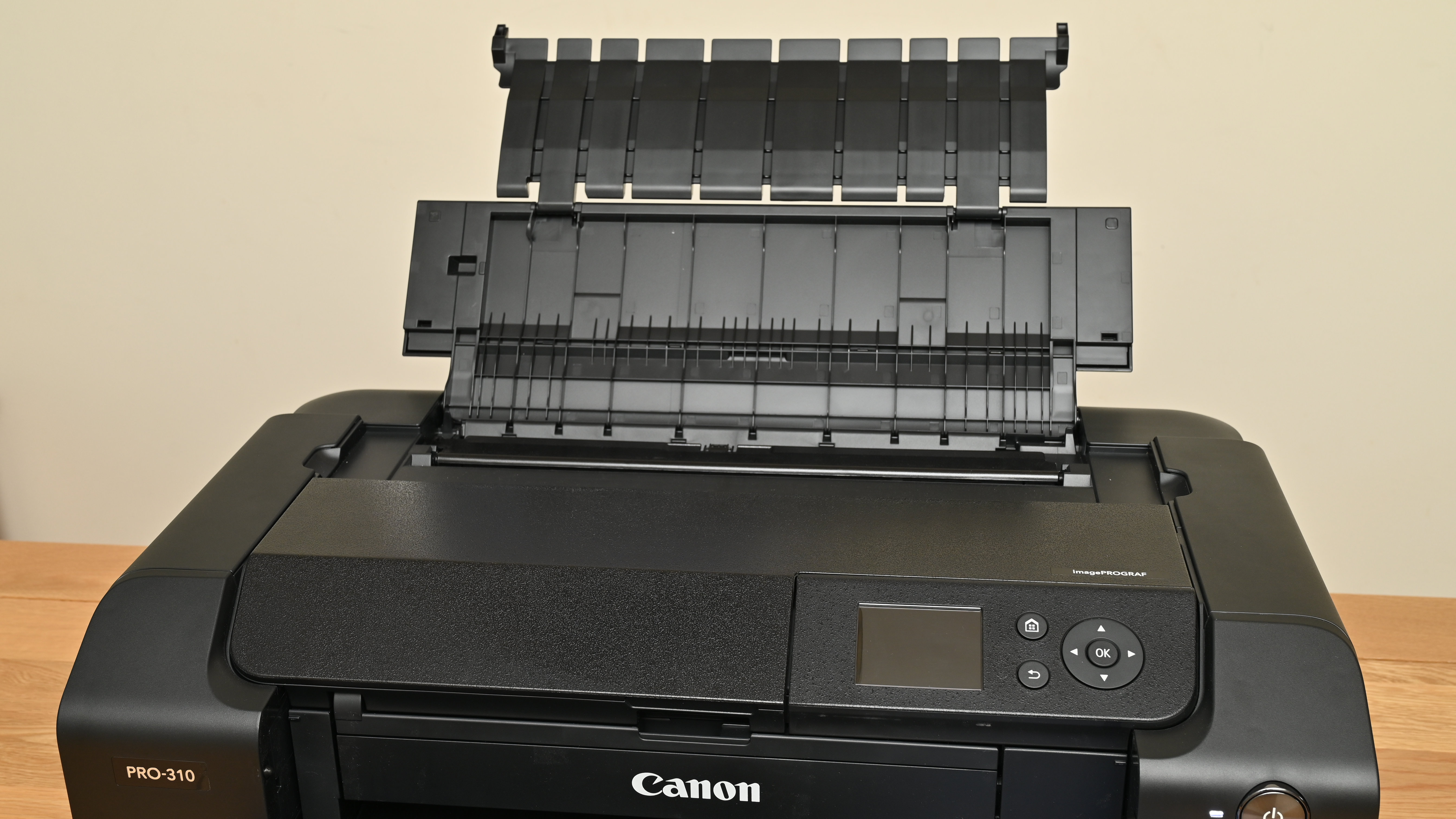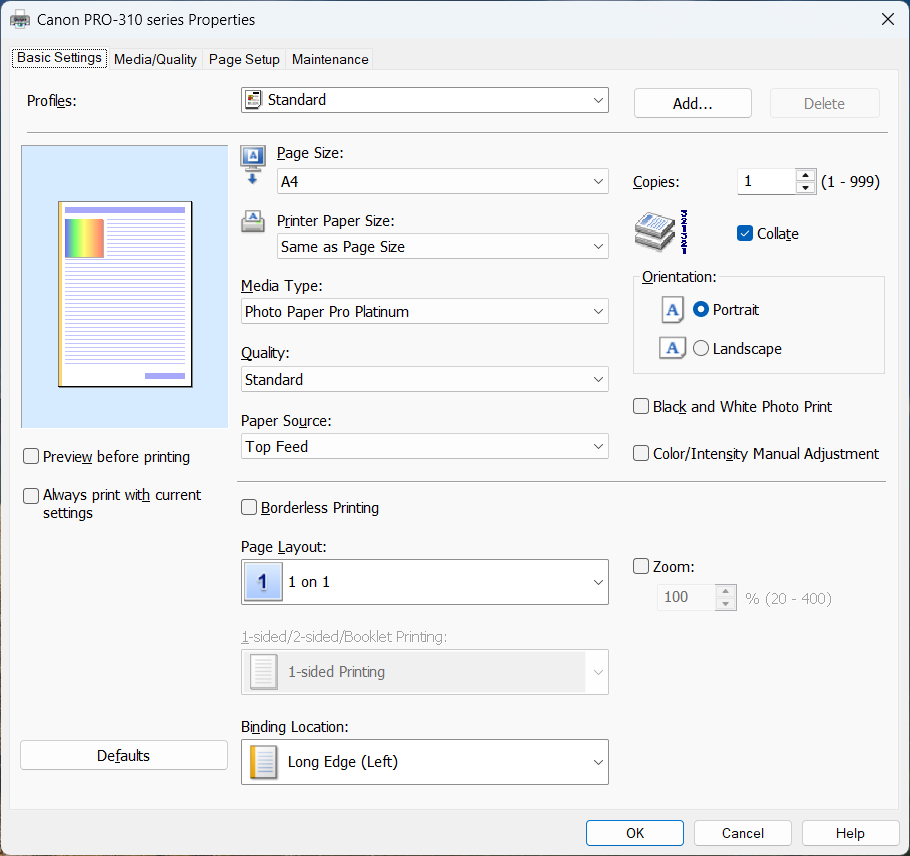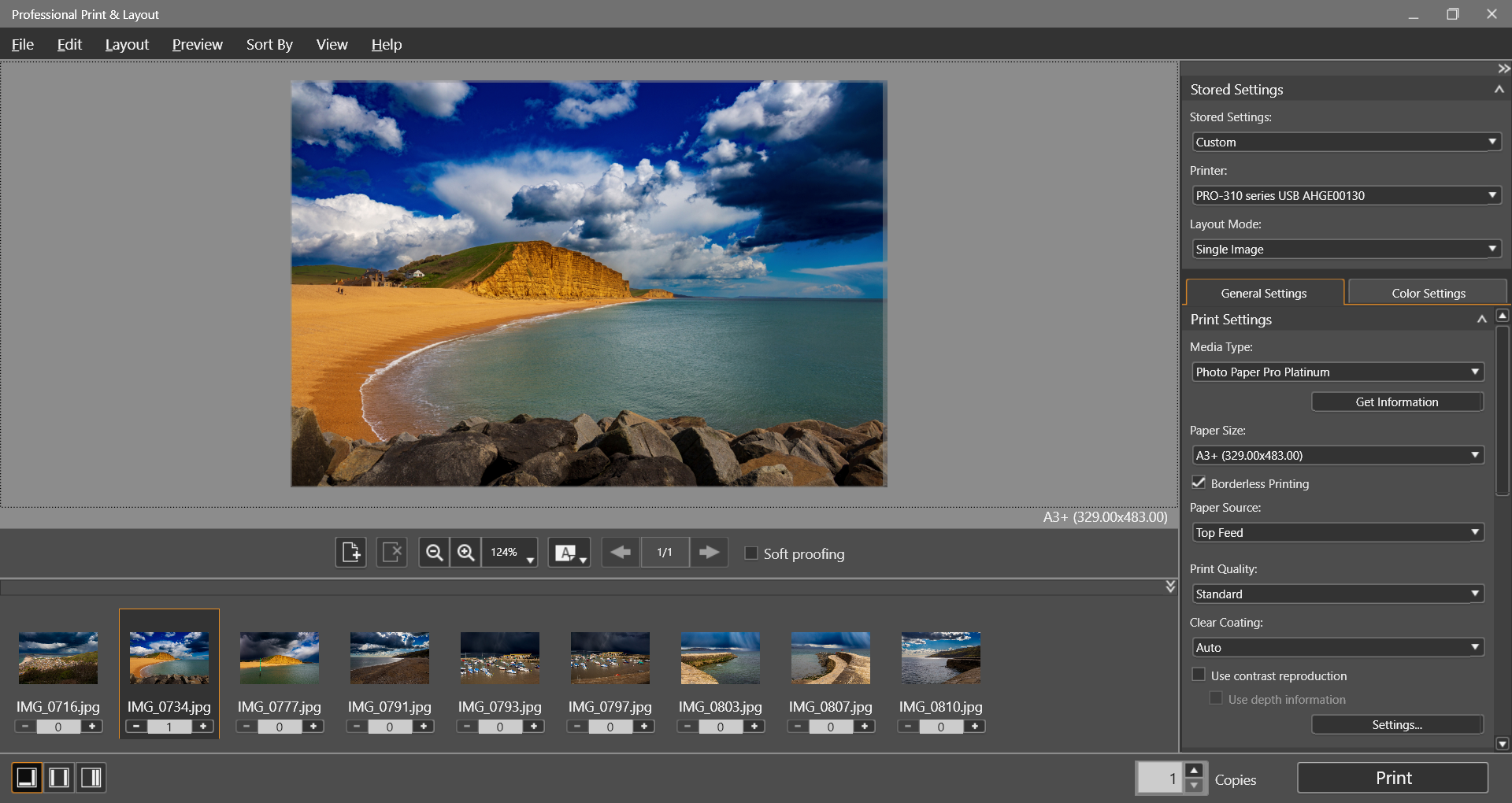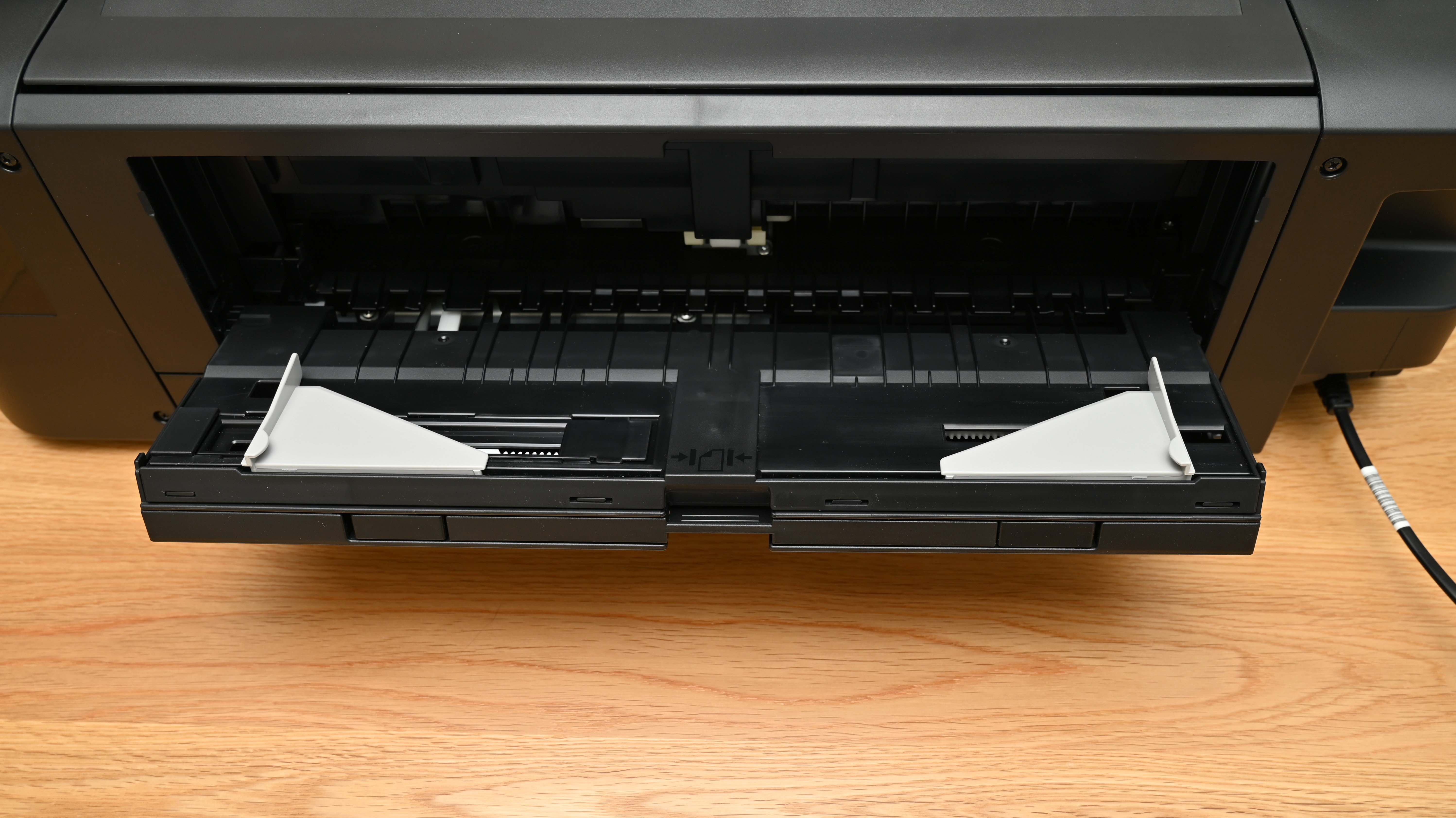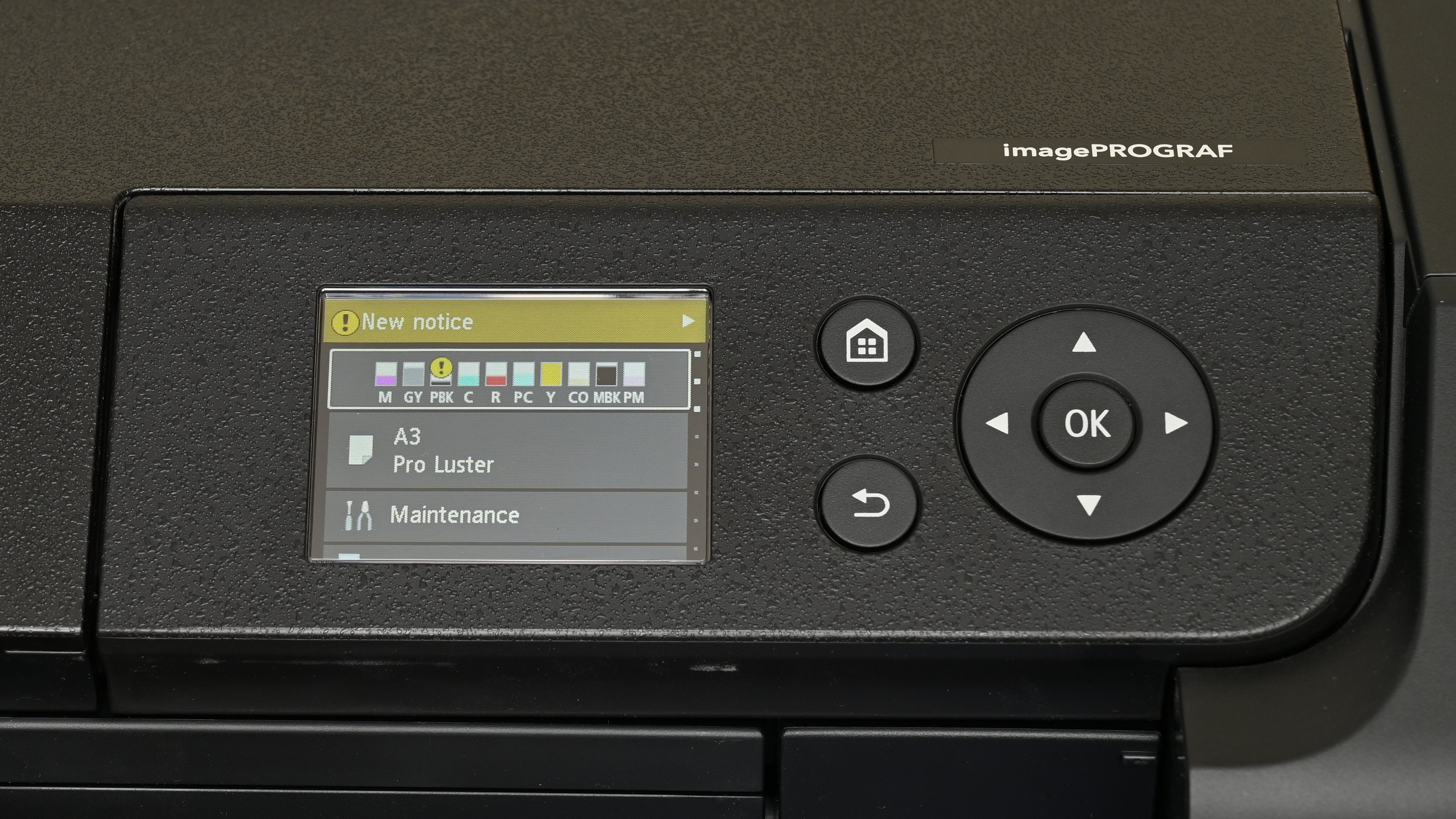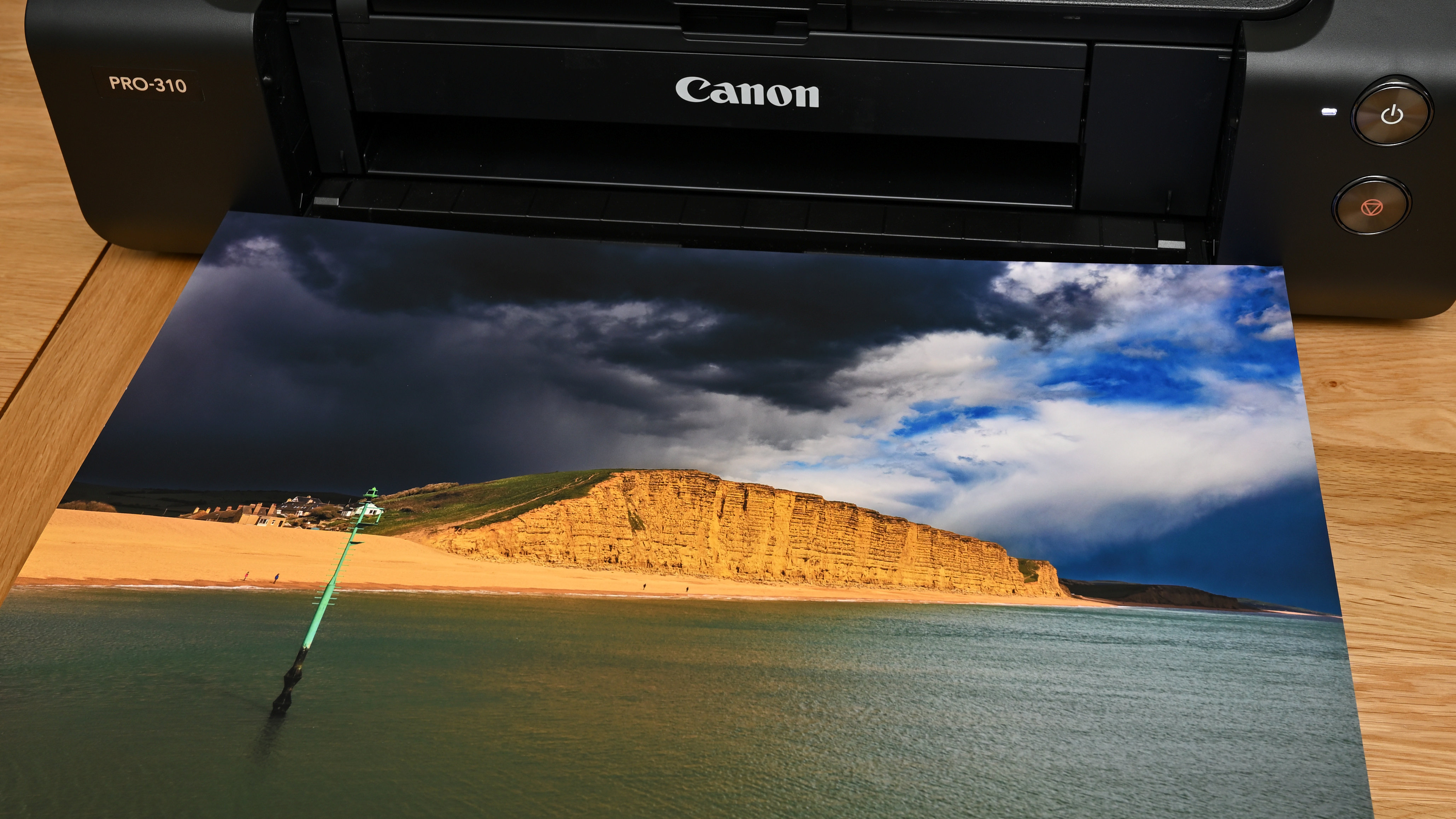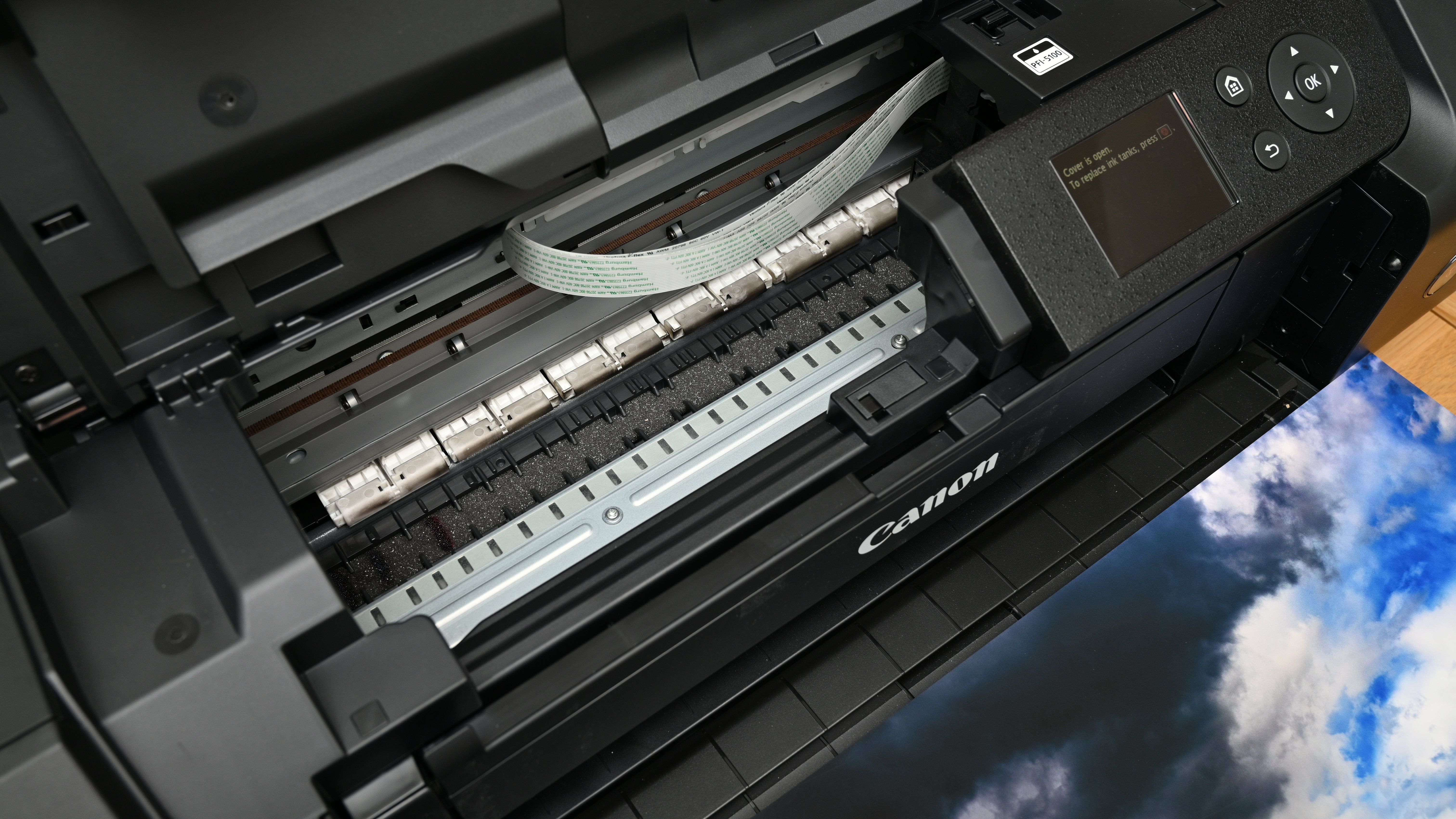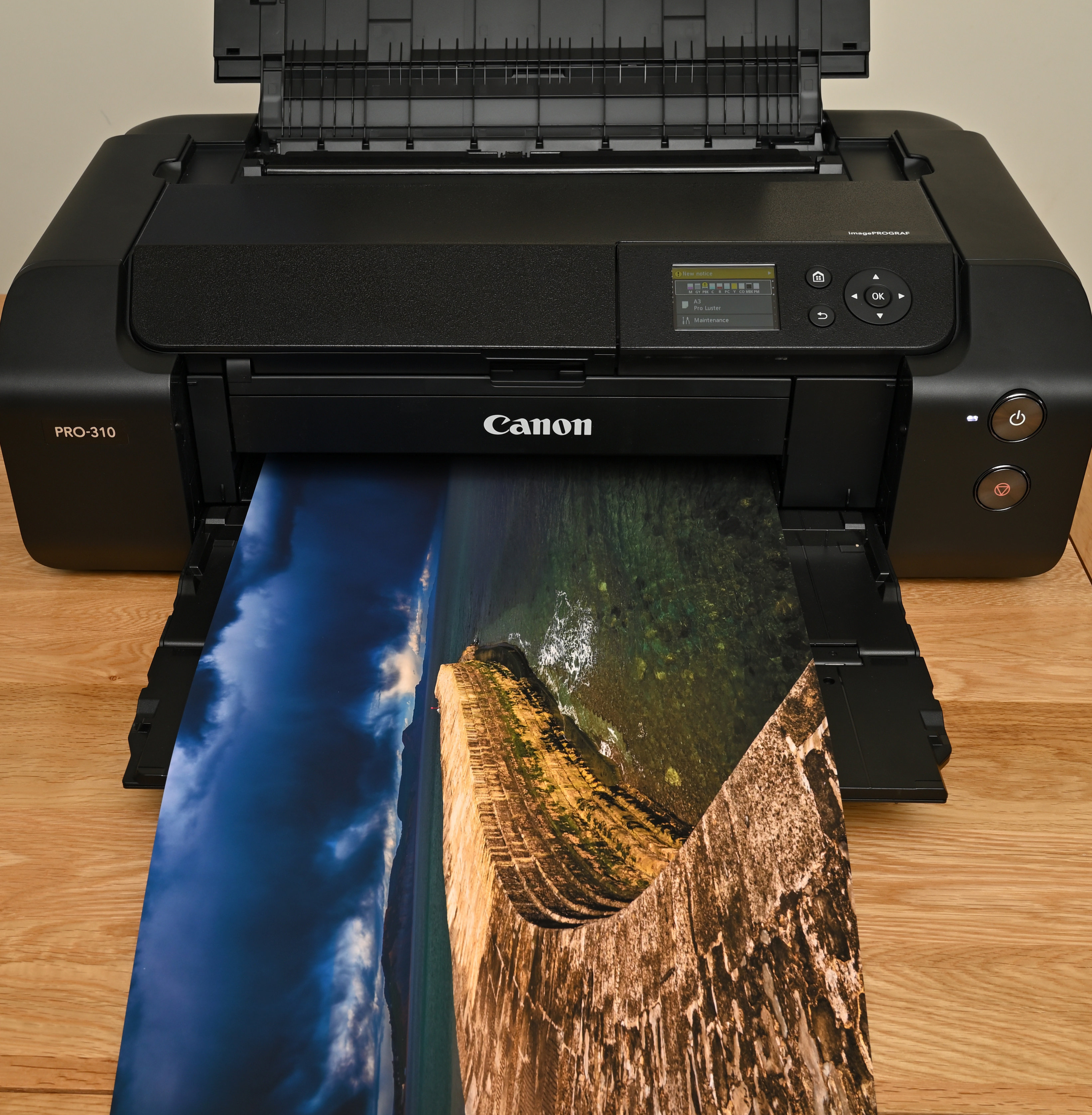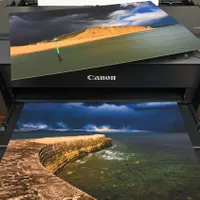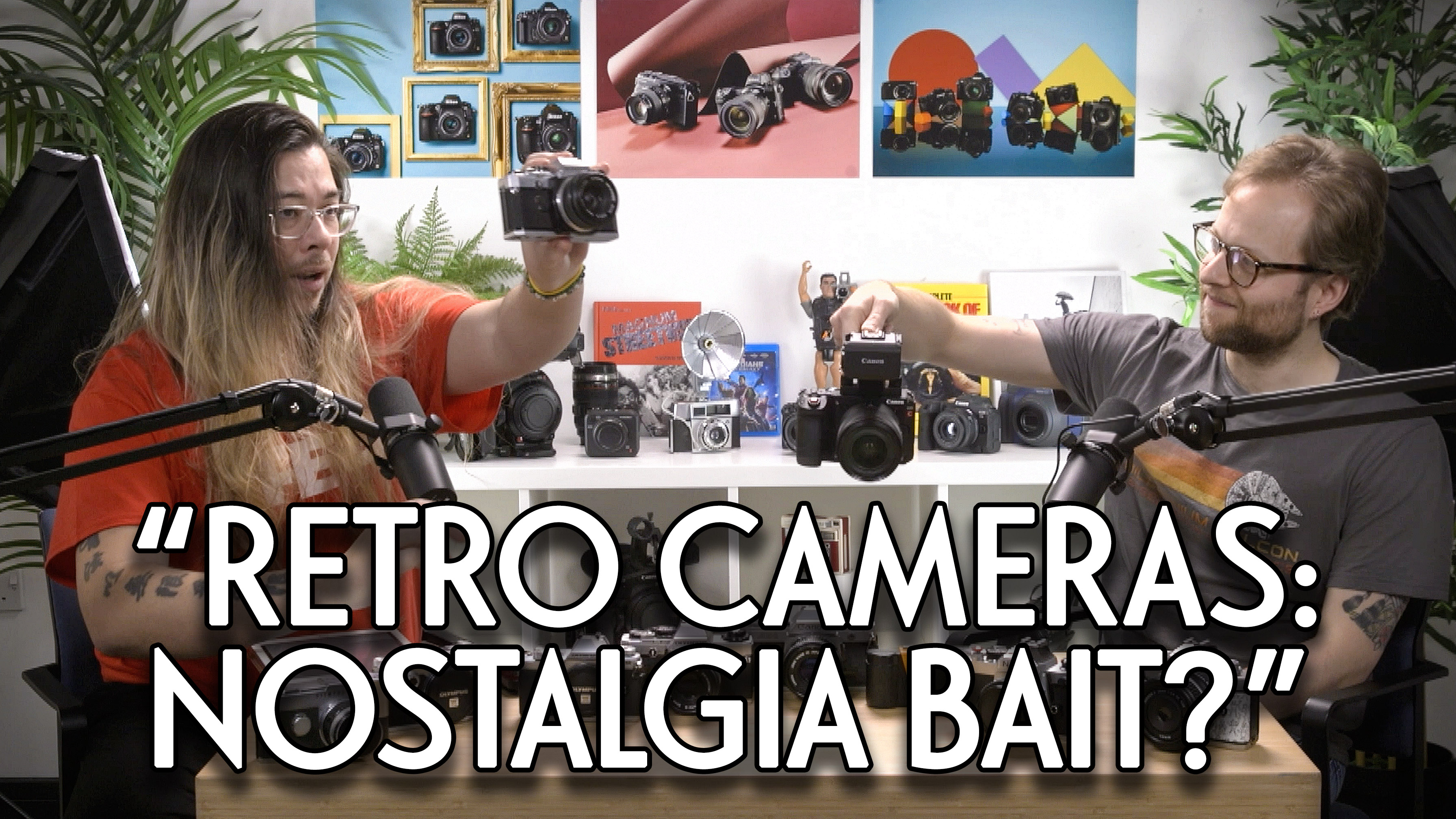Digital Camera World Verdict
The Canon ImagePrograf Pro-310 picks up the baton from the Pro-300, which was my all-time favorite A3+ / 13-inch photo printer. It looks virtually identical from the outside, which is no bad thing, but a new set of inks deliver even better image quality and prints are more robust and long-lasting. It also delivers super-sized panoramic output. I love it.
Pros
- +
Spectacular print quality
- +
Great for color and black & white
- +
Suits both glossy and matte papers
Cons
- -
Fairly low-capacity cartridges
- -
Not particularly fast
Why you can trust Digital Camera World
In the battle of the best large-format desktop photo printers, the Canon ImagePrograf Pro-1000 A2+ / 17-inch printer ruled the roost for nearly 10 years, but the smaller A3+ / 13-inch Pro-300 gave it a good run for its money. The latter’s ink set delivered even deeper blacks and ultra-dark shadows with greater detail.
In 2024, the newer Pro-1100 A2+ fought back with a reformulated set of 12 next-generation Lucia Pro II inks and retook the crown. Shortly afterwards, the Pro-310 followed hot on its heals, albeit with ‘only’ 10 inks under the bonnet, but with the same second-generation Lucia Pro II advantages, all packed into a printer that’s more conveniently compact and less expensive to buy.
All four printers are designed to deliver the ultimate in photographic print quality, suitable for professionals to make gallery prints for exhibitions and to sell their work. Let’s take a closer look.
Canon ImagePrograf Pro-310: Specifications
Inks/type | 10 pigment |
Max print size | A3+ / 13-inch, 1.8m / 70.9in panoramic |
Max print speed | A3+ with border, 4m 15s |
Max print resolution | 4800 x 2400dpi |
Input trays | 1x top, 1x rear, printable disk |
Scanner | None |
Display screen | 3-inch color LCD |
Interfaces | USB 2.0, Ethernet, Wi-Fi |
Dimensions | 639 x 379 x 200mm / 25.2 x 14.9 x 7.9in |
Weight | 14.4kg / 31.8lb |
Canon ImagePrograf Pro: Price
Considering that the Pro-310 is aimed at the most demanding professional and enthusiast photographers who want total control over creating prints at the highest level, I think that the asking price of $849 / £699 / AU$999 is very reasonable. If you don’t need to go larger than A3+ / 13-inch prints, this model only costs about two-thirds of the price of the larger A2+ / 17-inch PRO-1100, which retails for $1,299 / £1,099 / AU$1,799. The Pro-310’s ink cartridges are also less than a third of the price to buy.
There’s a catch though, in that the cartridges have a relatively low capacity of 14.4ml compared with the 80ml cartridges of the Pro-1100. The bottom line is that, per milliliter, ink for the Pro-310 costs about twice the price. A full set of 10 cartridges for the Pro-310 will set you back about $150 / $154 / AU$310.
Canon ImagePrograf Pro-310: Design & Handling
Nobody really wants to buy and run two photo printers, which creates a bit of a dilemma. Dye-based inks are best for glossy photo paper, as the relatively small molecules of ink are fully absorbed beneath the shiny outer layer. That means you get a really smooth finish with no ‘bronzing’ – a term given to areas of uneven reflectivity depending on the color and density of inks.
Conversely, pigment-based inks are better for matte photo paper and fine art media, as the larger molecules are more robust and resistant to fading, as well as giving greater image quality on these types of paper. However, bronzing can be a big problem if you use pigment inks on glossy paper. As with other ImagePrograf Pro printers, the Pro-310 aims to cover all eventualities.
The best camera deals, reviews, product advice, and unmissable photography news, direct to your inbox!
The trick is that while the Pro-310 has 10 cartridges, only 9 of them are actual pigment-based inks. The other contains a ‘chroma optimizer’ which is essentially a clear liquid that’s applied to glossy prints to smooth out the appearance and minimize bronzing.
Not only that but, as with the bigger Pro-1100, the chroma optimizer has been reformulated to give an even smoother finish. Another upgrade is that you can apply chroma optimizer selectively, ignoring the white borders of prints. And that’s just the start of the new cartridge appeal.
I was properly amazed when I first used the previous Pro-300 printer, as it delivered a black density the like of which I’d never seen before from an inkjet printer, or any printer come to that. The Pro-310 sets the bar even higher, with a new set of reformulated Lucia Pro II inks.
Overall image quality is claimed to be improved, especially in magenta hues, although the matte black ink remains unchanged. And that’s not all. The new inks include wax in their composition, which greatly reduces the risk of scratches and abrasion when handling, packaging and transporting finished prints.
Then there’s the matter of print longevity. If you’re a pro photographer selling prints to your clients, you want them to last a lifetime – preferably more, so they can be passed down through future generations. The new inks boost resistance to fading so you can hang prints on the wall and expect them to last for 200 years.
That’s something that I naturally can’t test for myself, but the figure is based on accelerated tests using Canon Photo Paper Pro Platinum, carried out by an independent lab of the Japan Electronics and Information Technology Industries Association.
In other news (or not) most of what made the Pro-300 such a great printer is thankfully unchanged in the Pro-310. Headline attractions include that it can create borderless prints on matte and fine-art media as well as just on glossy photo paper.
However, you need to disable the ‘safety margin regulation for paper size’ option in the printer driver, and it’s not a completely risk-free process. Even so, I created 20 or so borderless A3+ photo prints on Canon’s Premium Matte photo paper and Premium Fine Art Smooth media with no problems at all.
As I’ve come to expect, support isn’t limited to Canon’s own photo papers. Many professional and enthusiast photographers have their particular favorites from a wide selection of fine art papers made by the likes of Hahnemühle, Canson and Awagami. I like that a vast range of independent media is directly supported by the printer.
The supporting software is really good as well. The print driver is straightforward and intuitive, and there’s also Canon Professional Print & Layout, which is available as a free download. This works as a standalone program or as a plug-in for Adobe Lightroom and Photoshop, as well as for Canon’s own Digital Photo Professional, supporting different workflow options. The software enables soft proofing and hard proofing for many different paper types, as well as creating layouts of multiple images on the same page.
What I like most is that you can create ‘pattern prints’, where small versions of the image are printed multiple times on a sheet of paper, with subtle variations in the treatment of tone and color. You can then pick your favorite version for the final print, as well as saving it for future reference.
When it comes to build quality, the Pro-310 is no lightweight at 14.4kg. That’s good news as far as I’m concerned, as the printer has a really solid metal chassis and a pro-grade feel to its build quality throughout. There are dual paper feed options, including an upright feeder at the top and a manual rear feeder.
The latter is more suitable for thicker fine art media and also enables panoramic prints or banners of up to of up to 1.8m / 70.9in in length. That’s a considerable step up from the maximum length of 99.6cm / 39in for the PRO-300.
Well connected, the Pro-310 has built-in 2.4GHz Wi-Fi and wired ethernet, as well as the usual high-speed USB port. There’s also 5GHz Wi-Fi Direct, which was absent in the previous model, plus WPA3 and TLS1.3 security. The printer is compatible with the Canon Print app for Android and iOS, as well as various cloud-based services including AirPrint, Mopria, Canon Print Service and Cloud Link.
There’s a 3-inch color LCD screen and an intuitive set of onboard control buttons, which you can use for setting up different paper types for each feed path, carrying out routine maintenance and keeping a check on ink levels.
Canon ImagePrograf Pro-310: Performance
Print quality is simply spectacular for both color and black & white photo prints, and on both glossy and matte media. The key is in the new inks, and there are lots of them, including matte black, photo black, grey, cyan, photo cyan, magenta, photo magenta, yellow and red, plus the chroma optimizer.
The Pro-300 was fabulous in terms of color rendition and tonal range, right down to really dense blacks, and the Pro-310 is even better. For really black blacks, there’s no beating matte photo paper or fine art media, rather than glossy or luster papers.
I always think that reliability is a major factor in the performance of any large-format photo printer. Considering the price of ink and photo paper or fine art media, it’s massively frustrating if you go to the time, trouble and expense of creating a big print, only to find out that it’s ruined by faint lines across its surface. There can also be a problem if paper is fed on the skew, especially if you’re making borderless prints.
To ensure streak-free prints, the Pro-310 uses Canon's ‘FINE’ print head technology, which automatically checks for clogged nozzles in real time and swaps to adjacent nozzles if needed. It can do this thanks to a large built-in redundancy in the number of nozzles in the print heads. And to make sure the paper is fed with the utmost precision, the printer also features automatic deskew correction.
Pigment printers tend to be slower than dye-based printers and the PRO-310 is no exception. You also need to factor in drying time, whereas dye-based prints on glossy paper tend to be touch-dry pretty much as soon as they land in the output tray. Even so, prints from the Pro-310 are naturally a whole lot quicker than ordering prints online and waiting for them to turn up in the post.
In my tests, an A3+ borderless glossy print took 6m 30s in standard photo quality mode and 9m 30s in top quality mode. Borderless output on A3+ Premium Fine Art Smooth took 8m 20s in standard mode and 12m for highest quality. Downsizing to A4, I got print speeds of about 3m 20s in standard mode and 4m 30s in top quality mode.
Suffice it to say that the Pro-310 doesn’t keep you hanging around, waiting for prints. And anyway, if I’m creating a top-quality print that’s going to last for a couple of hundred years, I’m more than willing to wait a few minutes for it to be produced!
Canon ImagePrograf Pro-310: Sample prints
The following gallery contains a selection of prints that I made with the Pro-310 on Canon Premium Fine Art Smooth paper. This paper has a matte finish but I created borderless prints anyway, which is an additional challenge for the accuracy of the printer.
The images shown are photos of the finished prints, which themselves are prints of digital photos taken on the Dorset coast in the UK, under very moody and dramatic skies. There’s also a variety of other photos, mostly chosen for their large tonal range and very deep blacks, to show the printer’s abilities in this respect.

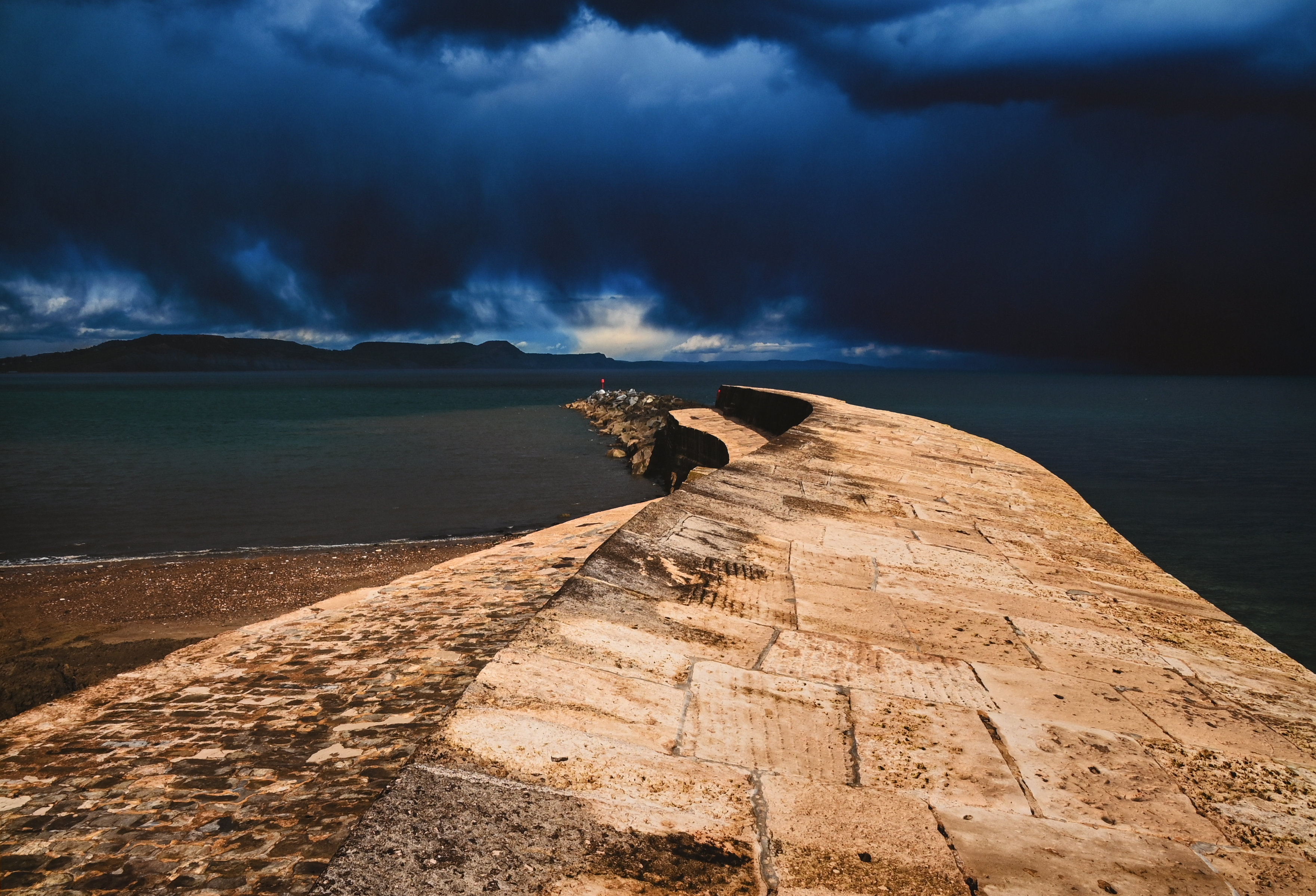
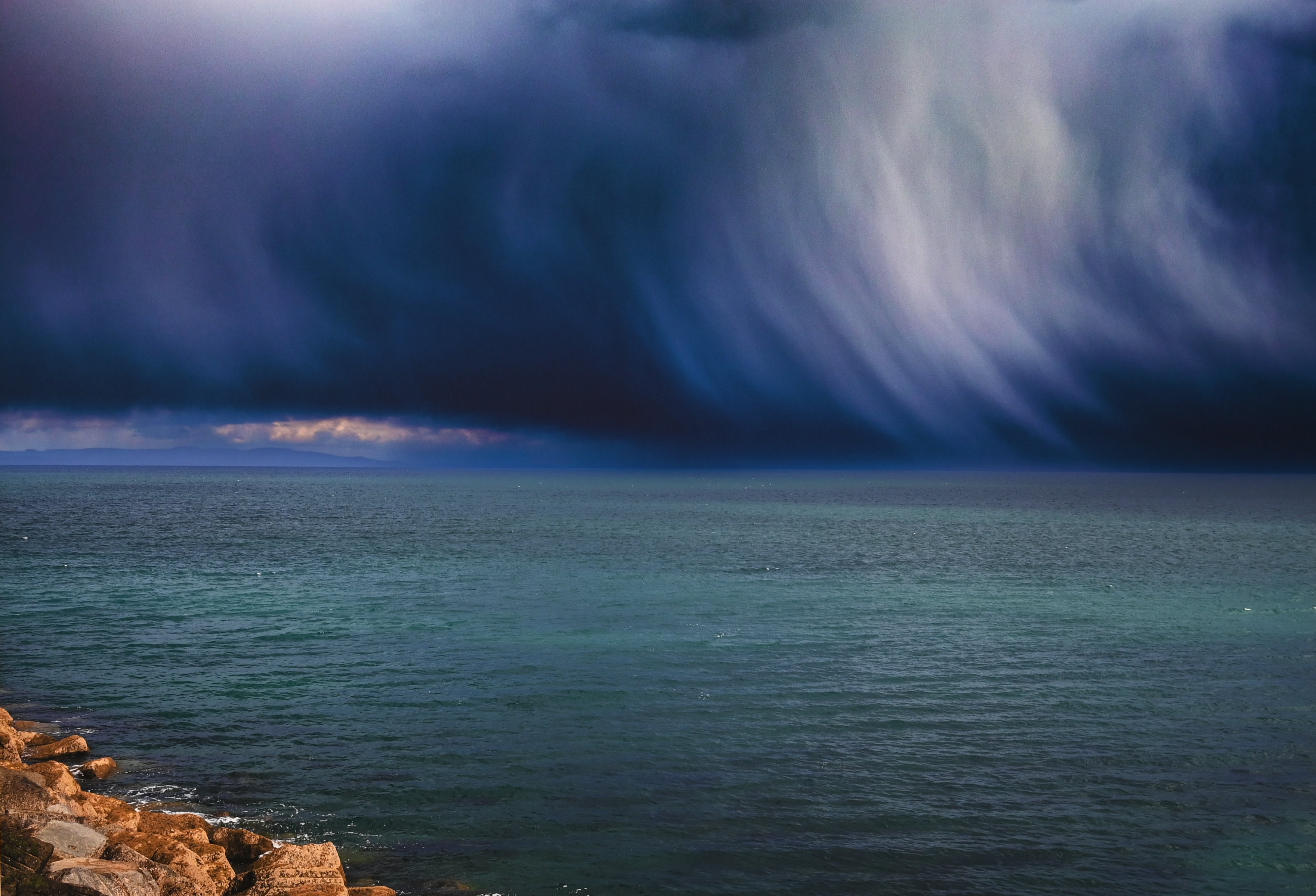
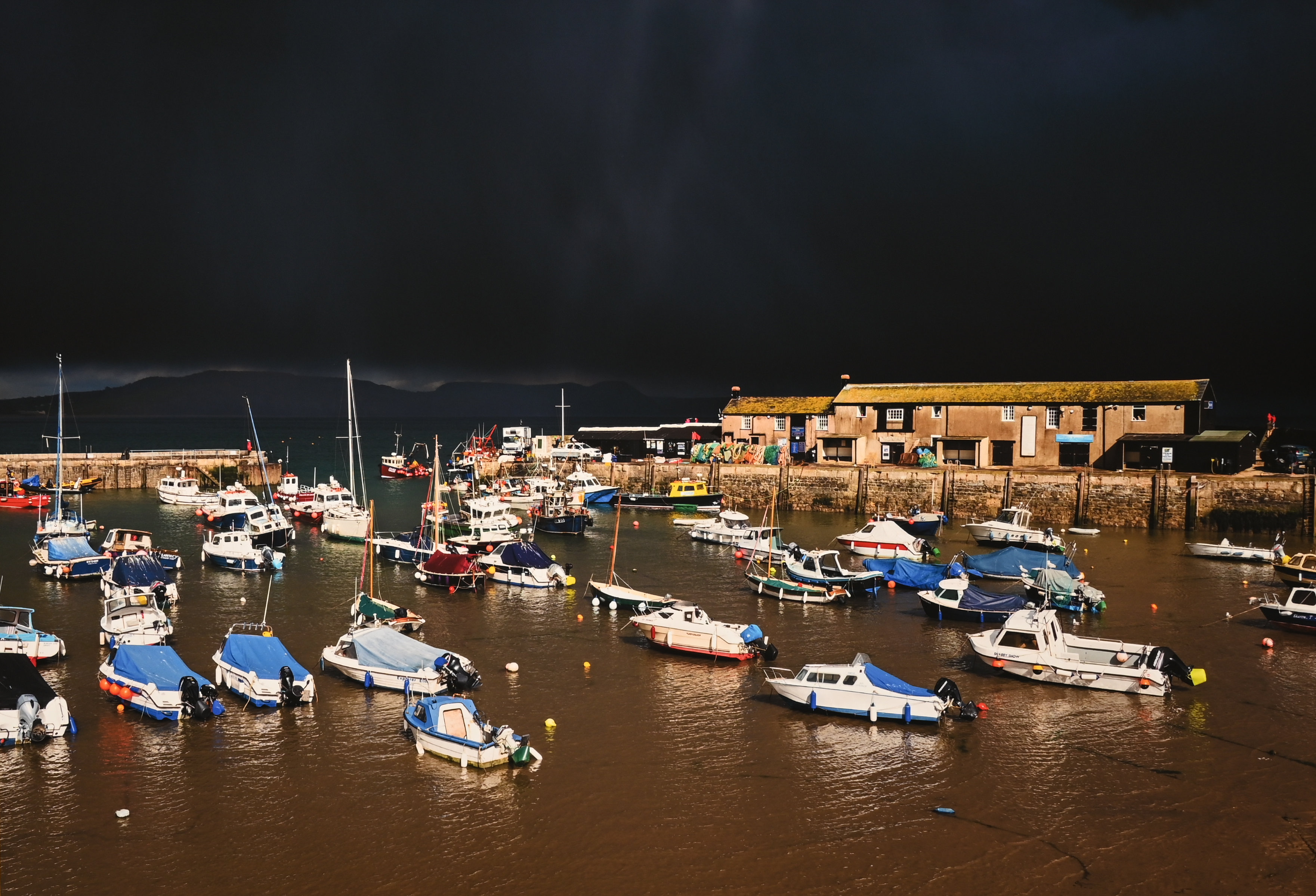
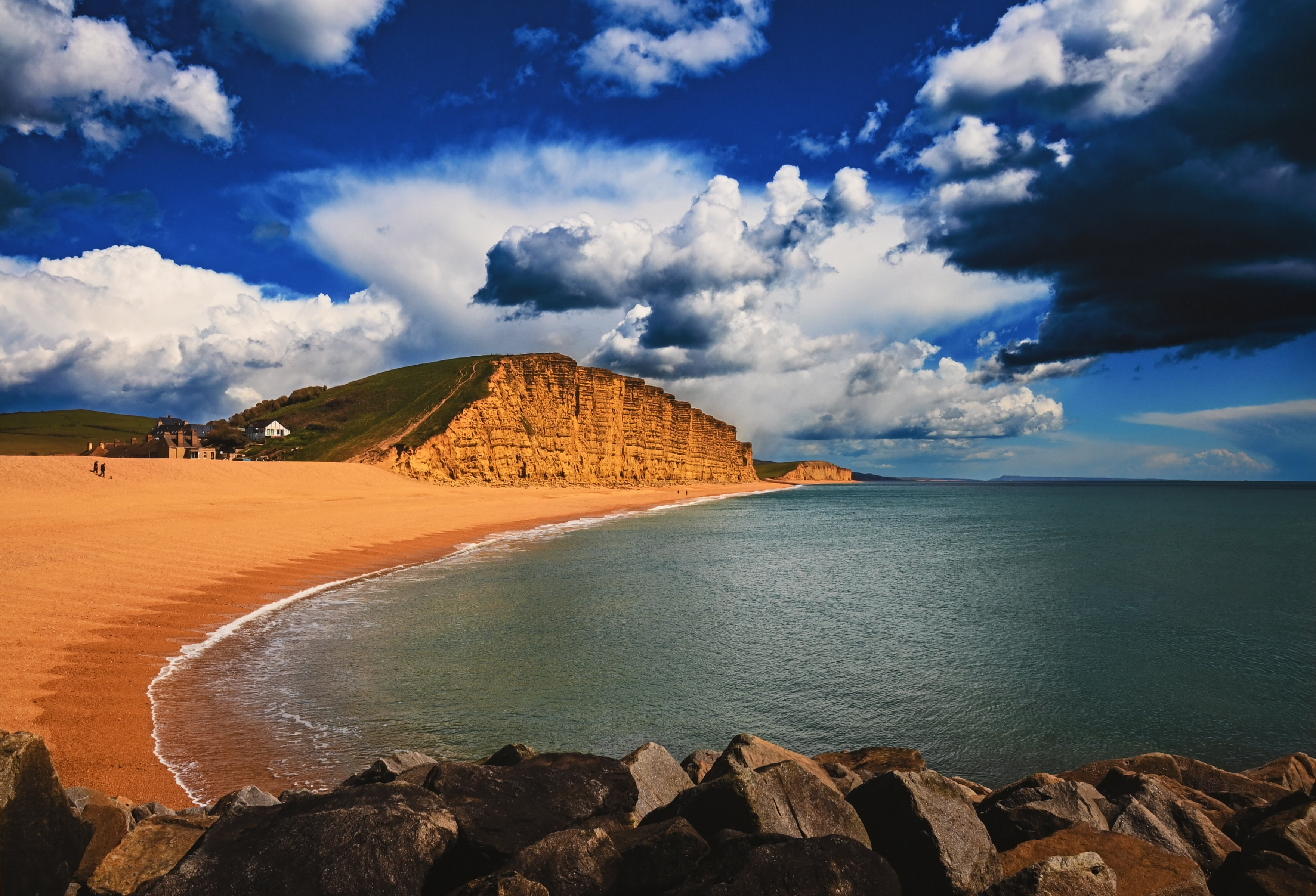
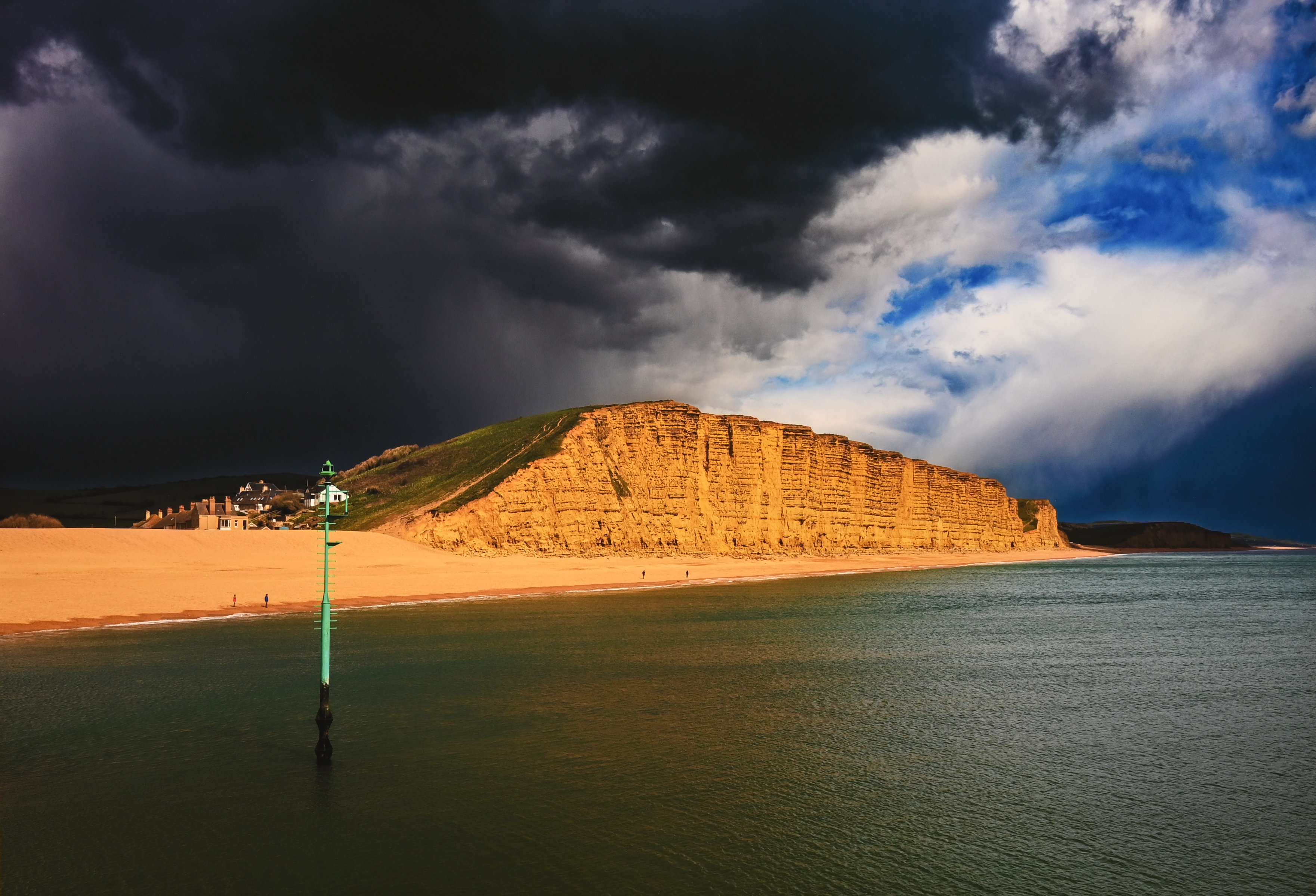
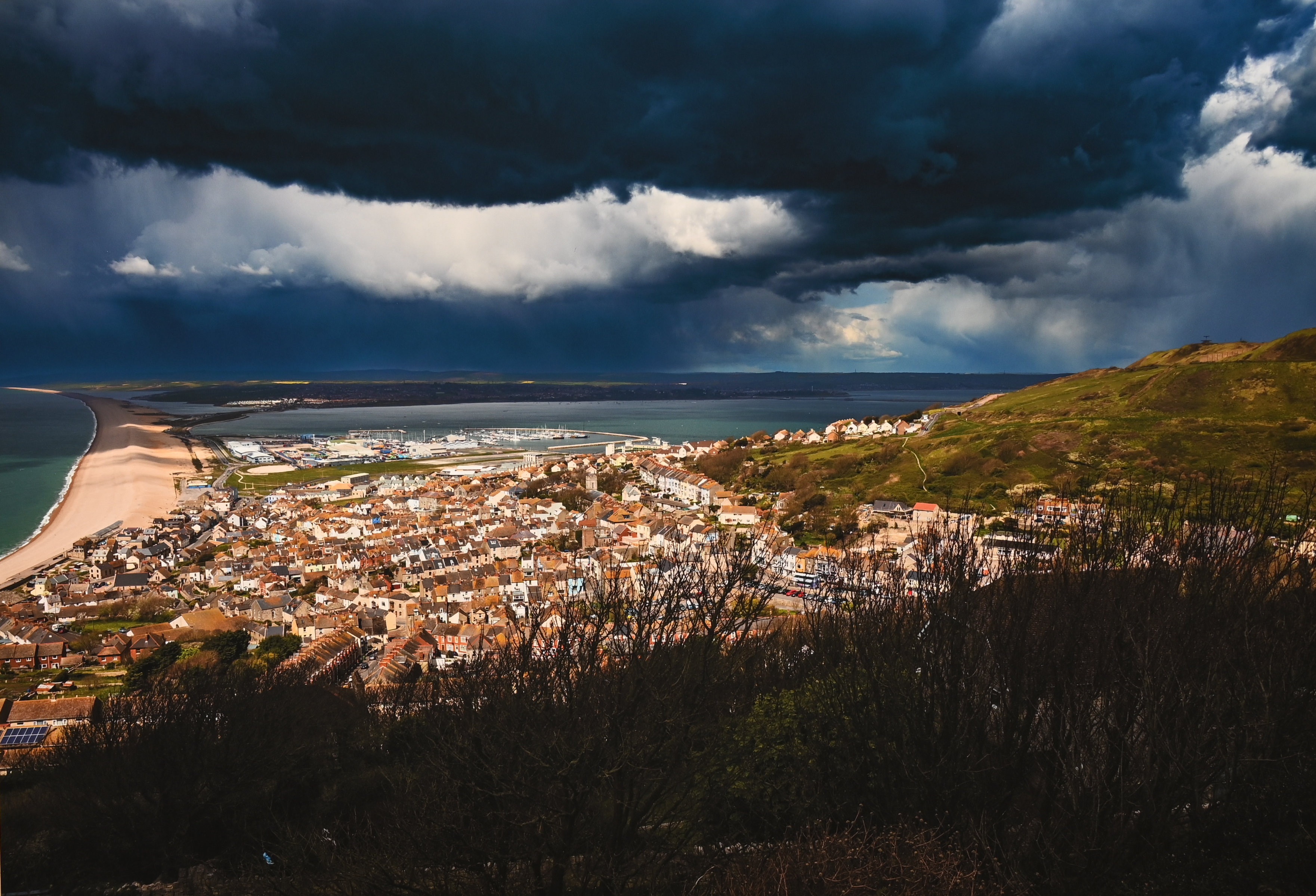
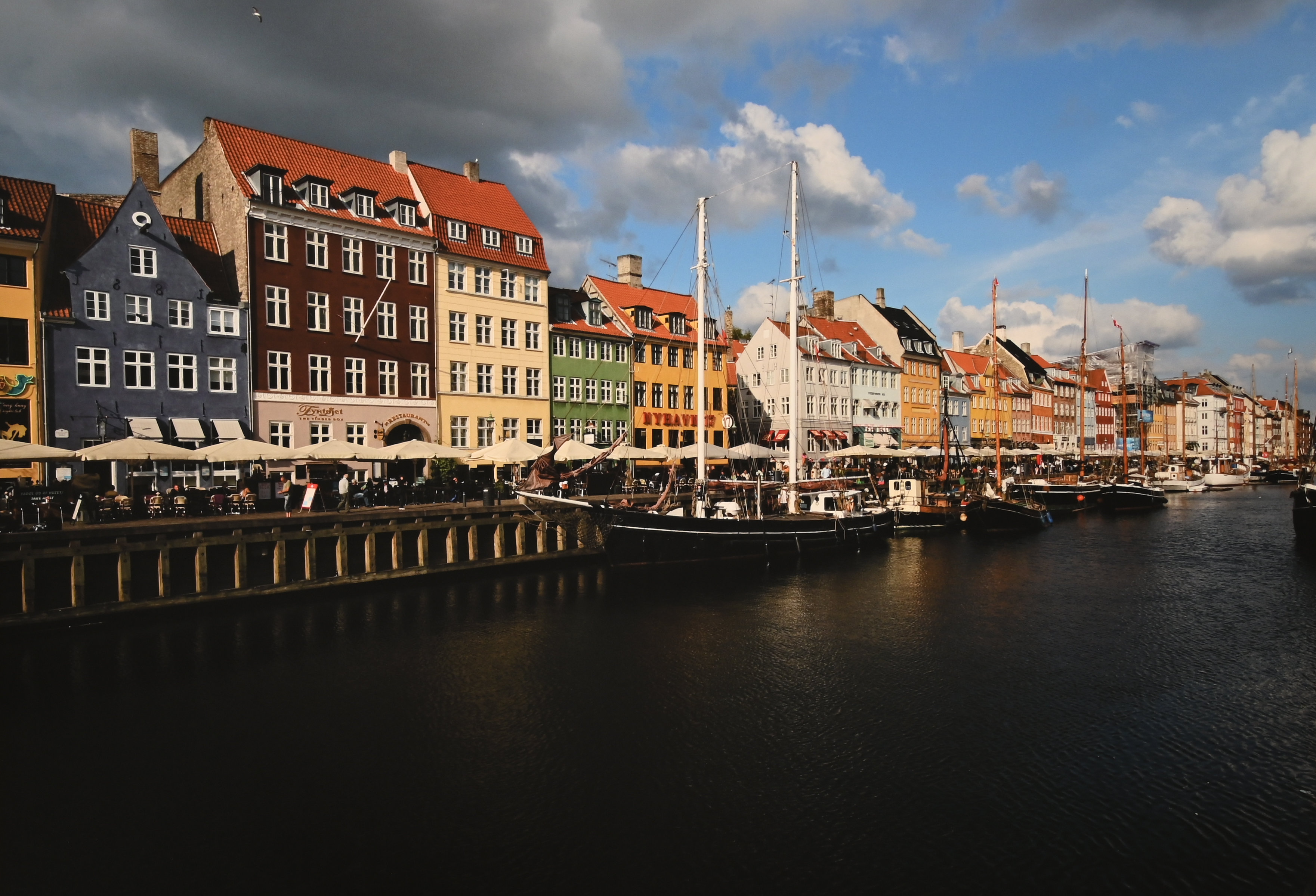
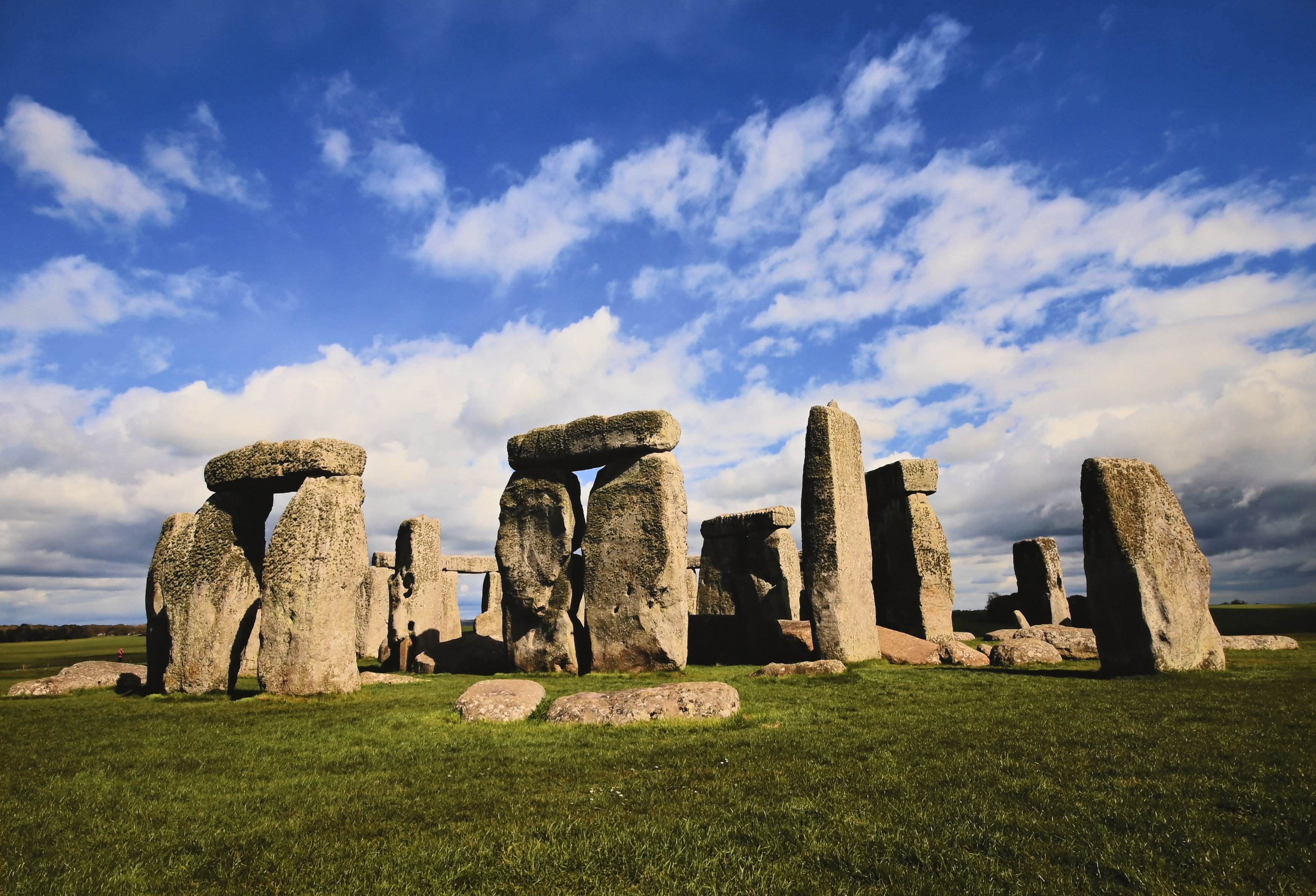
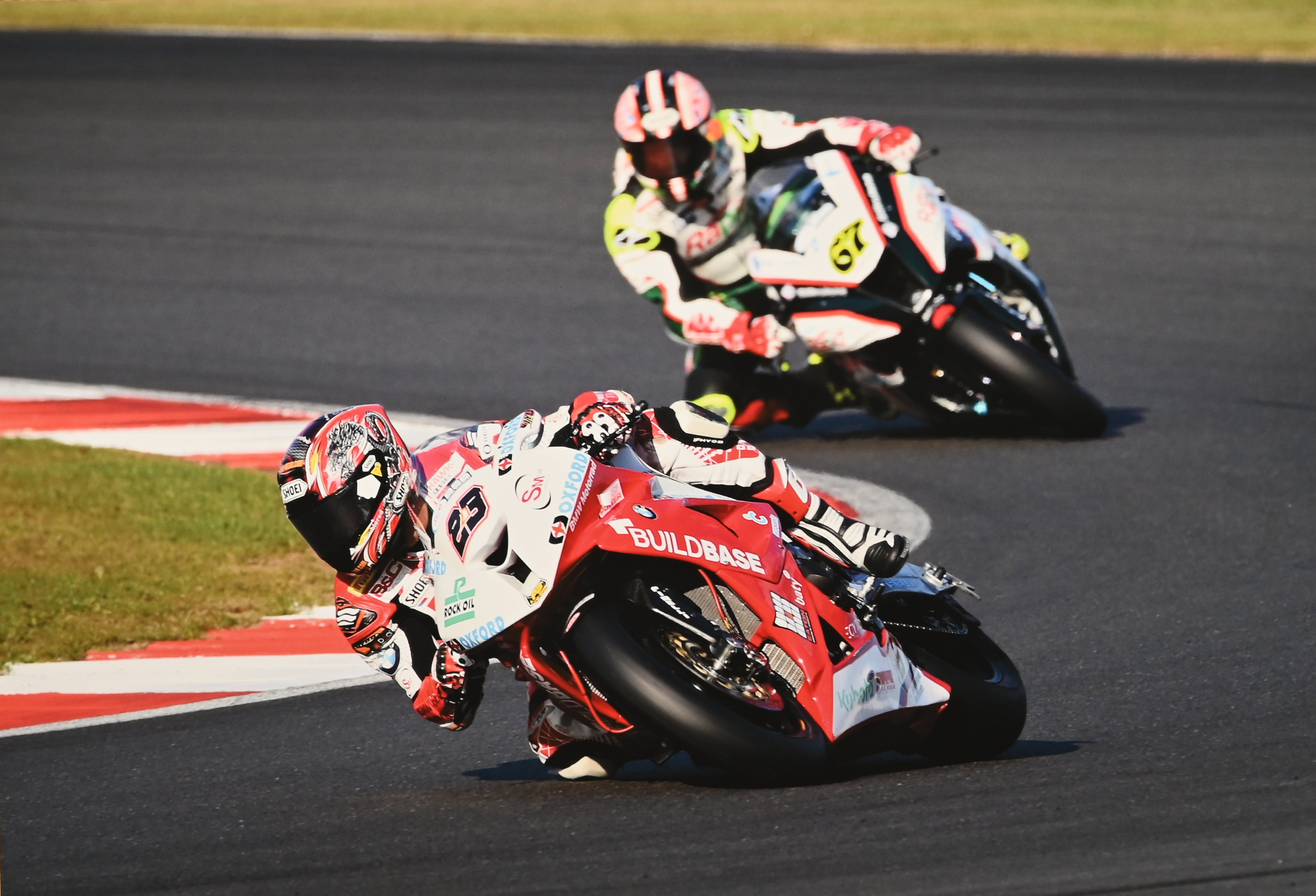
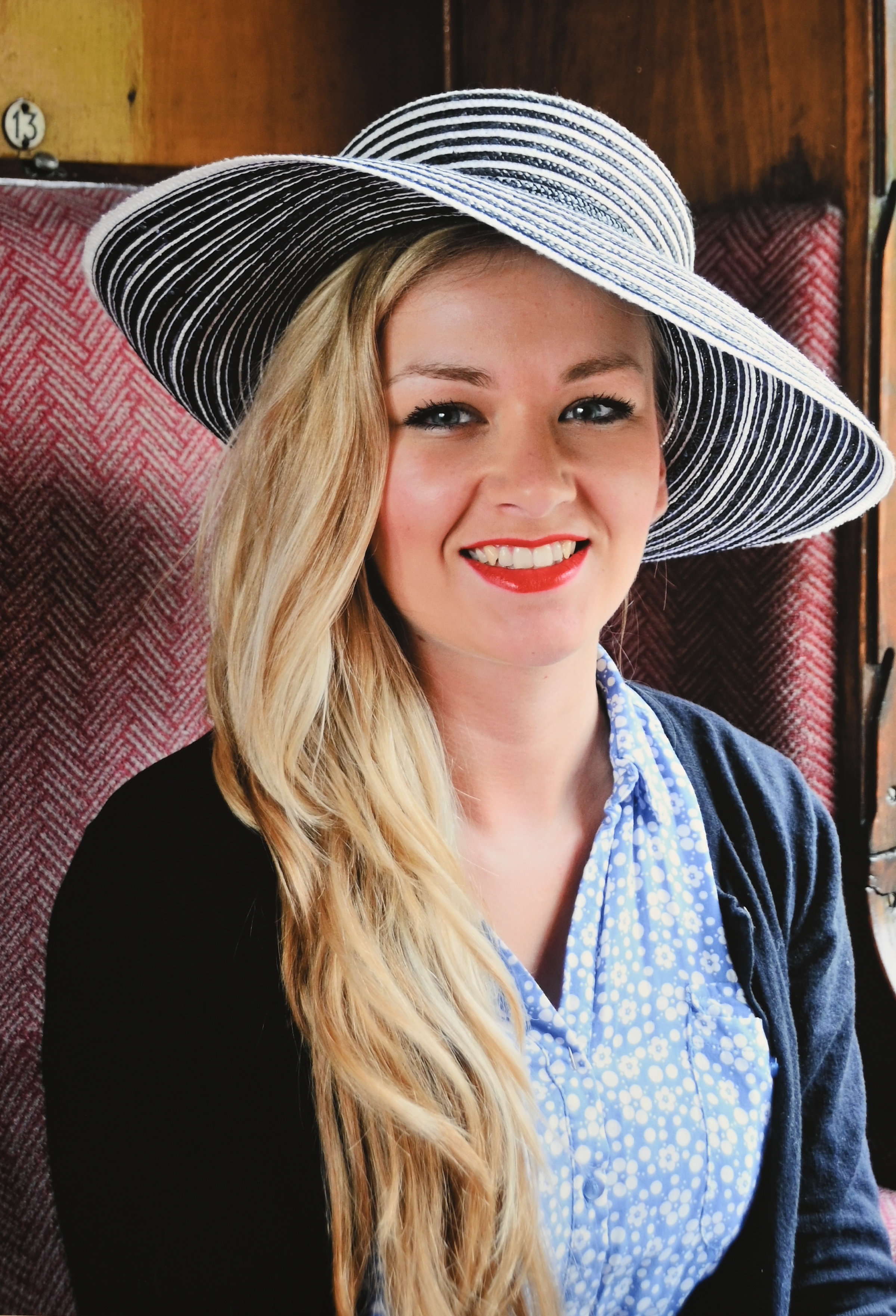
Canon ImagePrograf Pro-310: Verdict
I recently reviewed the amazing Canon ImagePrograf Pro-1100 A2+ / 17-inch printer. It’s absolutely fabulous but it’s a big chunk of a machine that needs a lot of real estate and weighs a hefty 32.4kg / 71.4lb. The Pro-310 is much more compact and manageable, weighing 14.4kg / 31.8lb (less than half as much). It’s also much more affordable to buy and, while it uses two fewer ink cartridges, the print quality is still utterly superb.
For me, it makes sense to buy the Pro-310 instead of the Pro-1100 and order my prints online on the rare occasions that I want to go larger than A3+ / 13x19-inch, or panoramas of more than 1.8m / 70.9in in length. My only disappointment with the Pro-310 compared with the Pro-1100 is that, drop for drop, ink works out to about twice the price. Even so, running costs are still pretty reasonable for a printer of this size and impeccable quality.
Features ★★★★★ | Top features include 10 pigment-based inks, dual paper feeds, borderless printing on matte as well as glossy media and panoramic/ banner printing. |
Design ★★★★★ | The printer is really solidly built and reassuringly weighty. The onboard controls and color LCD are nice to have and the overall design is impeccable. |
Performance ★★★★★ | It’s not the fastest printer in the world but is still pretty quick for a large-format pigment printer. And the print quality is absolutely sublime. |
Value ★★★★☆ | The printer itself is very competitively priced but ink works out to about twice the price compared with cartridges for the larger PRO-1100. |
Alternatives
The Canon Pixma Pro-200 is an A3+ / 13-inch printer that runs on dye-based rather than pigment-based inks. If you’re only interested in printing glossy and luster photo paper rather than using matte or fine-art media, it’s unbeatable.
The amazing Canon ImagePrograf Pro-1100 is a much larger and heavier A2+ / 17-inch printer, with two additional ink colors. It costs about 50 per cent more to buy than the Pro-300 but running costs in terms of ink cartridges are only about half as much.
Matthew Richards is a photographer and journalist who has spent years using and reviewing all manner of photo gear. He is Digital Camera World's principal lens reviewer – and has tested more primes and zooms than most people have had hot dinners!
His expertise with equipment doesn’t end there, though. He is also an encyclopedia when it comes to all manner of cameras, camera holsters and bags, flashguns, tripods and heads, printers, papers and inks, and just about anything imaging-related.
In an earlier life he was a broadcast engineer at the BBC, as well as a former editor of PC Guide.
- Adam WaringGuides Editor
You must confirm your public display name before commenting
Please logout and then login again, you will then be prompted to enter your display name.
